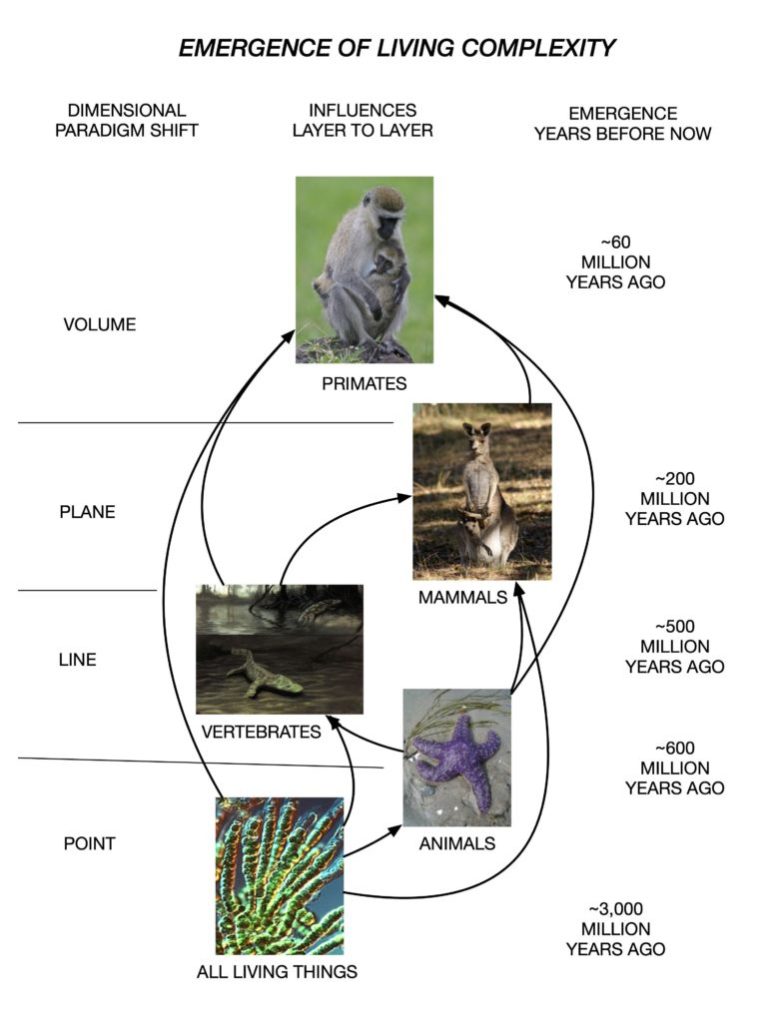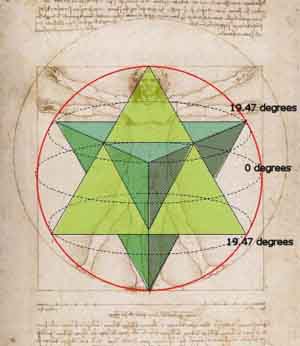Introduction
“Geometric Evolution” offers a unique perspective on the intersection of evolutionary biology and geometry, delving into the profound ways life has adapted and evolved through various spatial dimensions. This exploration is not just a tale of biological progress but also a geometric narrative, revealing how life’s journey is intricately bound to the dimensions it occupies. This framework has equivalent utility for exploring cognitive and physical evolution.
The foundational premise is that life could only have evolved sequentially through the dimensions, starting with the temporal, and then expanding one spatial dimension one at a time.
The Point Dimension
– The Genesis of Life:
The narrative begins in the ‘Point Dimension,’ a phase of evolutionary history where life exists in a rudimentary form, devoid of spatial awareness and purely anchored in the dimension of time. Here, the essence of life is encapsulated in the continuous flow of metabolic processes – a miracle of existence and continuity that is fundamentally biochemical. The Point Dimension signifies a phase where the concept of space is abstract and non-physical, focusing instead on the temporal aspect of life’s processes…
In our physiology, these processes are expressed in our gut and Enteric Nervous System.
The Line Dimension – The Dawn of Movement:
As evolution progresses, life takes a monumental leap into the ‘Line Dimension.’ This shift marks the beginning of movement in the evolutionary chronicle. Primitive organisms such as slugs demonstrate this transition through basic locomotion – a linear expansion and contraction. This simple form of spatial interaction serves as the foundation for more complex and diverse forms of life. The evolution from a temporal dimension to a spatial one, though a process spanning billions of years, eventually catalyzes a significant diversification in the animal kingdom…
In this dimension, movement is initially a reflexive action, a primal response to external stimuli. Evolution, however, enhances this capacity, leading to more sophisticated forms of movement, integrating senses such as vertebrate physiology and vision. This development necessitates the evolution of specialized tissues – muscles for actuation and nerves for sensory processing. These biological advancements open avenues to new forms of energy consumption and reproductive strategies, crucial for the proliferation and diversification of life…
In our physiology, these processes are expressed in our musculoskeletal system, Sympathetic Nervous System, and Brain Stem/Cerebellum neurology.
The Plane Dimension – Mastery of Two-Dimensional Space:
Advancing further, life embraces the ‘Plane Dimension,’ navigating through the realm of two-dimensional space. Here, the spatial journey becomes more complex, with organisms developing lateral movements. The geometry of two-dimensional space allows for more intricate interactions and mobility, leading to a rich tapestry of life forms and behaviors. The Plane Dimension is marked by enhanced spatial awareness and increased adaptability, facilitating complex survival strategies and ecological interactions…
In our physiology, these processes are expressed in our anterior/posterior flexion of the spine allowing for complex movement as well as our Mammalian mid-brain and sophisticated auditory processing.
The Solid Dimension – Conquering Three-Dimensional Space:
The pinnacle of geometric evolution is the ascent into the ‘Solid Dimension’ – the realm of three-dimensional space. This dimension represents the zenith of spatial mastery, where organisms develop the ability to maneuver through sophisticated and varied environments. The ability to climb, fly, burrow, and navigate complex terrains is a testament to the advanced spatial awareness and adaptability developed over millions of years. This dimension encompasses a vast array of behaviors and environmental interactions, showcasing life’s remarkable flexibility and resourcefulness…
In our physiology, these processes are expressed in the evolution of our hands for tool use and our neo-cortical neurology.
Complexity in Geometric Evolution:
As the narrative of geometric evolution unfolds, it becomes apparent that this journey is not merely a progression through increasing dimensions. Each new dimensional leap brings complexity to interactions, ecological niches, and survival strategies. The evolution from the Point Dimension to the Solid Dimension is a story of life’s unyielding quest to explore, adapt, and thrive in the ever-changing tapestry of its environment.
Conclusion:
The concept of “Geometric Evolution” presented here is an outline of what could be a detailed study of physiology from an evolutionary perspective, charting a course through the dimensions of life, illustrating how evolution is not just a tale of biological adaptation but also a geometric saga. As life forms evolved, they mastered increasingly complex geometrical spaces, evolving from a one-dimensional temporal existence to sophisticated, multi-dimensional beings. This progression did not replace but rather extended the underlying physiology – an evolutionary biology concept called Exaptation. We are a mixture of all of these geometric evolutionary epochs. Understanding how they interact from a geometric perspective might help to elucidate their complex interactions.
As with those creatures inhabiting a subset of Spacetime, only aware of the dimensions that they had evolved into, we may yet experience further evolution into more a complex dimensional space as that potential is revealed.


